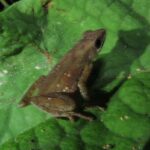- Meet the Rare and Elusive Forest Guardian: <em>Ischnocnema gualteri</em>
- Taxonomy and Classification
- Natural Habitat: The Quiet Eden of Brazil's Atlantic Rainforest
- Physical Characteristics: An Elegant Master of Camouflage
- Behavior and Life Cycle: Secrets of Survival
- Ecological Role: Essential Part of the Forest Fabric
- Threats and Conservation Status: An Urgent Call for Protection
- Cultural and Scientific Significance: Embracing the Web of Life
- Conclusion: Guardians of the Forest Future
Meet the Rare and Elusive Forest Guardian: Ischnocnema gualteri#
When twilight descends upon the lush Atlantic Forest of Brazil, an orchestra begins—a symphony crafted by beings often too small to see, yet powerful in their role within the ecosystem. Amidst the whispers of leaves and the rhythmic hum of insects, a rare creature calls out gently: a distinctive broadcast summoning life. Hidden within cool mossy undergrowth, camouflaged by leaves and shadow, is the humble protagonist of our story: Ischnocnema gualteri.
This small terrestrial frog, largely unnoticed in casual wanderings, holds a treasure trove of insights into ecological balance, biodiversity health, and the efforts needed to preserve our rapidly diminishing rainforests. Delicate yet resilient, mysterious yet critical, Ischnocnema gualteri embodies a story worth telling—not only because of its captivating behaviors but because the frog prompts a deeper reflection on our relationship with the natural world.
Taxonomy and Classification#
Belonging to the family Brachycephalidae, Ischnocnema gualteri is nestled securely within the diverse monophyletic group of frogs native exclusively to Central and South America. Its genus—Ischnocnema—contains numerous species celebrated by herpetologists for their unique terrestrial lifestyles and reproductive strategies.
First described scientifically by Lutz in 1974, Ischnocnema gualteri has enjoyed particular interest due to its secretive habits and narrow distribution, prompting scientists to better document its habits and ecology. Its close relatives showcase similarly adapted terrestrial features, each species occupying specialized ecological niches, contributing to the extraordinary diversity typical of neotropical amphibians.
Natural Habitat: The Quiet Eden of Brazil’s Atlantic Rainforest#
The existence of Ischnocnema gualteri is intrinsically tied to one of the most precious ecosystems on Earth—the Atlantic Forest (Mata Atlântica) in southeastern Brazil. Once sprawling dramatically across the Brazilian coast, this biodiversity hotspot has now been reduced to fragments, small islands of rich green amid expanding agriculture and urban sprawl.
Habitat Preferences and Microecosystems#
This frog has developed specialized preferences for humid forest pockets rich in undergrowth, shaded leaf litter, moss-covered rocks, and fallen logs. It thrives within these microcosms, seeking refuge beneath leaf piles and rotten wood, absorbing moisture from the surroundings—a direct adaptation valuable in dampening evaporation effects from the forest floor.
The Atlantic Forest environment provides an ideal backdrop for the amphibian’s nighttime activities. Cooler temperatures, combined with ample humidity, nurture populations of insects and small invertebrates—prime menu choices for this insectivorous amphibian.
Physical Characteristics: An Elegant Master of Camouflage#
Ischnocnema gualteri is an inconspicuous beauty. At its maximum size, adults rarely exceed 25 millimeters, making this frog easy to overlook at first glance. Yet upon close observation, a subtle magnificence emerges. From its slender limbs adapted to stealthy movements amid the forest debris, to its varying shades of brown and reddish-orange hues, this species is an exemplar of evolutionary craftsmanship.
Notably, the frog’s coloration matches its habitat almost perfectly—a camouflage refined over countless generations. Variations in spots, stripes, and points of pigment aid in breaking its outline, protecting it from predators like birds, larger frogs, and snakes, simultaneously enhancing its hunting success.
Adaptations for Survival#
A few remarkable species features ensure that Ischnocnema gualteri thrives, even when threatened. Its skin, a permeable yet moisture-conserving organ, serves the dual role of hydration and camouflage. Powerful rear legs allow nimble leaps, facilitating rapid escapes from sudden threats, making it an elusive quarry not easily caught.
Behavior and Life Cycle: Secrets of Survival#
The veiled existence of Ischnocnema gualteri extends beyond its cryptic appearance. Active predominantly during mild, humid nights, it displays nocturnal behaviors of both predator and prey within its secluded forest niche.
Diet and Hunting Technique#
This agile predator relies on stealth and patience—critical skills for ambush-based hunting. Small insects and arthropods moving through their nightly routines inadvertently enter the ambush zone precisely designed by our waiting protagonist. Employing a combination of excellent night vision and vibration sensing, this little amphibian strikes with impressive speed, ensuring successful hunts night after night.
Reproductive Wonders#
Perhaps the most fascinating characteristic lies in its reproductive biology. Unlike many amphibians, Ischnocnema gualteri displays direct development—it bypasses a free-swimming tadpole stage entirely. Instead, fully formed froglets hatch directly from terrestrial-laid eggs, hidden carefully among damp leaf piles or beneath rotting logs.
This strategy is advantageous, allowing survival in regions lacking permanent water sources. Nonetheless, it ties the species’ fate closely to forest conditions, emphasizing the importance of terrestrial habitat conservation efforts.
Ecological Role: Essential Part of the Forest Fabric#
Though modestly sized, Ischnocnema gualteri fills critical roles in its habitat. It manages insect populations effectively, contributing to local ecological balance. Simultaneously, it serves as prey for an array of predators, closing nutrient cycles elegantly. Indirectly, this amphibian acts as an environmental indicator, signaling forest health and overall ecosystem stability.
Threats and Conservation Status: An Urgent Call for Protection#
Despite its critical ecological importance, the frog faces severe threats primarily caused by human actions. Habitat destruction remains the most significant risk, driven by relentless logging, urbanization, agriculture, and mining encroachment within its limited range. Fragmentation reduces genetic diversity, isolating populations and sealing their fate without immediate intervention.
Climate change provides another looming specter, shifting rainfall and temperature patterns, potentially pushing suitable habitats to elevational extremes or altering humidity regimes that sustain the frog. The amphibian chytrid fungus—widespread among frogs globally—is another significant risk factor, stressing the need for monitoring and early intervention.
Currently classified by the International Union for Conservation of Nature (IUCN) as Data Deficient, further careful surveys and research are urgently needed to outline targeted conservational strategies. Preserving this frog means preserving an entire ecosystem and its myriad interconnected life-forms.
Cultural and Scientific Significance: Embracing the Web of Life#
While lesser-known culturally due to its elusive nature, amphibians like Ischnocnema gualteri hold great scientific significance. Researchers increasingly recognize the invaluable roles posed by small terrestrial frogs, not just ecologically but pharmacologically. Understanding chemicals and peptides in their skin could yield medicinal breakthroughs—making each species potentially precious for human health.
Beyond practical benefits, this elusive frog symbolizes the hidden wonders of the natural world, representing the interconnectedness and fragility of life—making it an extraordinary ambassador for conservation education and action.
Conclusion: Guardians of the Forest Future#
The story of Ischnocnema gualteri is a tale of quiet resilience, exceptional survival tactics, and an undeniable plea for conservation. Every small-leap and gentle nighttime chorus is an integral stitch in the rich ecological fabric sustaining the Atlantic Forest. As nature enthusiasts, educators, and conservation advocates, we carry the responsibility to safeguard their habitats, undertake rigorous studies, and maintain conscientious attitudes towards biodiversity.
This humble creature, so easily overlooked yet deeply impactful, invites our attention and respect. By advocating for its survival, we advocate for ourselves and the future of life on Earth. It’s a call worth heeding—a gentle chorus we must not silence, but amplify.
Ready to join in protecting these incredible frogs and their vibrant rainforests? Explore our conservation resources, engage with local environmental initiatives, and embrace a commitment to preserve biodiversity, ensuring species like Ischnocnema gualteri remain ambassadors of Earth’s irreplaceable ecosystems.







